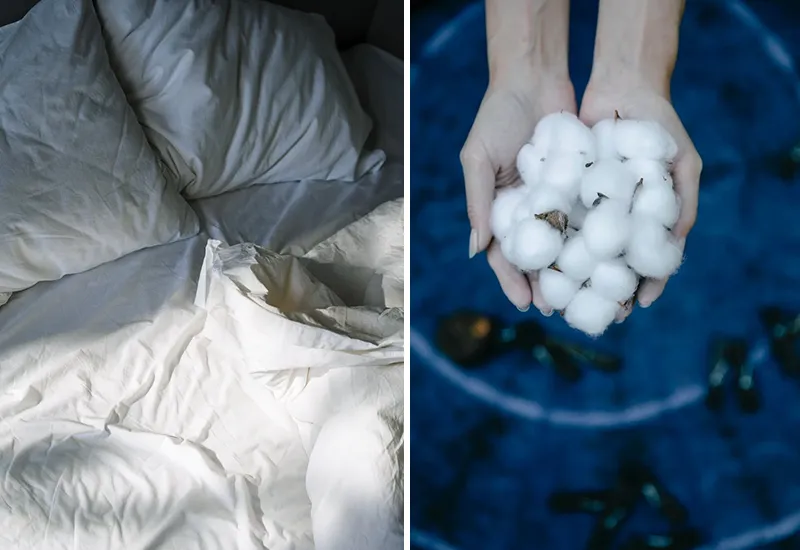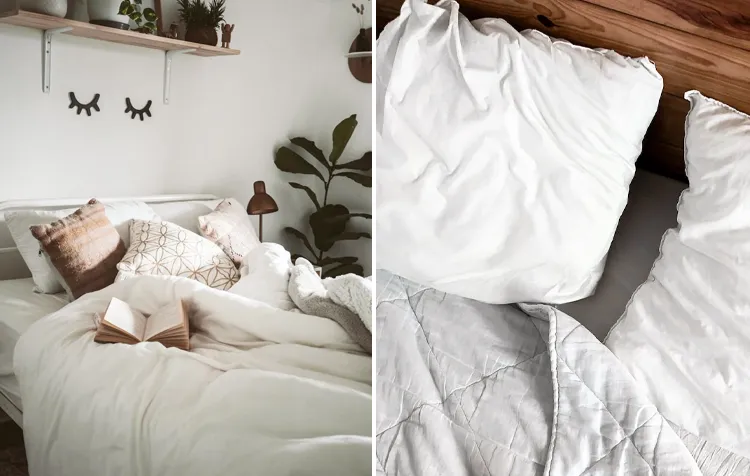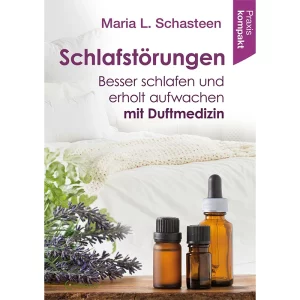Looking for sustainable bedding and want to know what to look for when choosing truly eco-friendly comforters, pillows or comforter covers? Then you've come to the right place!
We spend around a third of our lives in our beds. So it's hardly surprising that more and more people prefer high-quality bedding. But by striving for the best possible live sustainably, their sustainability is of course also playing an increasingly important role.
In this article, I have therefore compiled the most important tips & tricks for environmentally friendly bedding. You'll learn what to look for when buying and what tricks you can use to ensure that you enjoy them for as long as possible. Let's go!
10 tips: When is bedding sustainable and what to look out for?

We are all trying to improve our Furnish bedroom as sustainable as possible. For this play next to furniture, plants, carpets or lamps Of course, the bed textiles or bed linen also play a major role. These are the very fabrics that protect bedding from wear and tear and make it more hygienic.
These include in particular the remuneration for Pillows and comforters, fitted sheets, but also Mattress protector or topper. Use the following tips now to get yourself some truly sustainable bedding - and to be as eco-friendly as possible with it.
1. Prefer natural materials
Sustainable bedding generally relies on a variety of materials that are are used in the production. Especially organic cotton, linen and hemp are recommended. Here I would like to explain briefly why this is so.
Organic cotton
Cotton is durable, soft and easy to work with. For the production of certified Organic cotton becomes Massive savings in water and energy compared to conventional production.₁ The use of pesticides is also prohibited, which also benefits the soil and thus nature.
Linen
Flax is mostly grown and processed into linen goods in Europe. This allows the Keep transport routes short and Reduce CO2 emissions.
The high-quality fabric is ideal as sustainable and healthy bedding, as it is cuddly, moisture-absorbent and anti-allergenic. In addition, it is Very resistant and therefore much more durable than conventional fabrics.
Hemp
Bed covers made of hemp are a good and environmentally friendly choice both in summer and winter. In the cold season they are warming and in hot temperatures they have a cooling effect.
Since the material is also very absorbent, bed covers made of hemp are also particularly suitable for those of us who sweat heavily at night. The cultivation of the hemp plant also requires very little water, as the roots of the plant reach up to three meters into the ground.
Tip: You should stay away from synthetic comforter covers, as they are based on the limited raw material petroleum, the extraction of which causes, among other things, high CO2 emissions and often also Environmental degradation goes hand in hand.
2. Know different varieties of organic cotton.
Certified organic cotton is not only an environmentally friendly material, but also Very versatile. Today there are Bed linen made of high quality cotton in different variants. Most popular are the following three types, which you can use to guide your selection.
Cotton satin bedding
Cotton satin bedding is made of cotton satin, that is, 100 percent natural cotton. The fine thread and tightly woven material is especially appreciated for its silky-luxurious skin feel and good temperature climate.
Jersey bedding
Due to the special knitting structure, small, fine stitches are created, which give the jersey comforter covers their High elasticity lend. In addition, they have a temperature-regulating and breathable effect. So jersey bedding is not only durable, but also wonderful to use all year round.
Renforcé bed linen
Renforcé is made of a soft, smooth cotton fabric. On the skin it feels very pleasant. In addition, Renforcé bedding acts temperature compensating and promotes the Moisture exchange. Basically, it is ideal for hot summer nights, but also for frosty winter nights.
3. Be sure to look for environmental label for bed linen.
So sustainable bedding is made from natural materials. So far, so good! However, when buying them, you should look a little closer and make sure that they are From controlled organic cultivation originate
At well-known labels like Fairtrade, OEKO-TEX or GOTS (Global Organic Textile Standard), you can tell directly whether these are really fairly produced, sustainable comforter covers.
4. Decide for bed linen from fair, regional production
Sustainability, of course, refers not only to the material, but also to fair and resource-saving production. This includes above all the Work under humane conditions. Are fair wages paid in the supply chain? And what are the working conditions and labor laws in the respective country of manufacture? You can get certainty here, among other things, through the Fairtrade seal.
It is even better if the bed linen is made locally in Germany, because this way Long transport routes, which is the Climate Change be avoided. On the other hand, giving preference to regional goods promotes the local economy.
By the way: Many manufacturers now only produce their products to order in order to avoid overproduction and to keep the Throwaway Society to counteract. This, too, is an important step toward greater sustainability.
5. Use resource-saving recycled bedding

In a sustainable bedroom definitely belongs bedding made from recycled fabrics. It will from already used textiles or other recycled materials, thus creating valuable natural resources be spared.
Their production process is also less energy and water intensive than with conventional bedding. Nevertheless, you benefit from a cuddly and comfortable sleep feeling - just with a significantly smaller ecological footprint.
Tip on the side: Did you know that not all Plants for the bedroom are suitable? Green lily and jasmine, for example, are among those that promote sleep. I'll be happy to explain which other plants are recommended in the linked article.
6. Repair bedding if it is possible
Instead of disposing of them in the used clothing container or taking them to the nearest recycling center, you should still try to repair damaged bedding. Often it is only small Cracks, holes or detached seamswhich can be easily repaired with a little skill and patience. But the important thing is that you start in time, so that the damage does not become even greater.
Repairing not only ultimately sustainable, it also gives your bedding a second life and makes them an absolute Unique.
7. Rethink old bedding
The repair is not possible? No problem! You don't necessarily have to replace the entire bedding set if only part of it is damaged. Often can be conjure up color-matching combinations from different sets. For example, a lime green sheet can harmonize beautifully with the pillowcase of another series, if both colors are coordinated.
In addition, creative upcycling ideas are available to use the fabrics in other ways. For example, an old comforter cover can, with a little skill, be transformed into a Pillowcase, a scarf or a practical shopping bag be transformed.
This way you give the material a second life and save natural resources for the purchase of the things you upcycle from them. In addition, it gives your home furnishings, your outfit or your household a individual, personal touch.
8. Basically focus on quality and high quality workmanship.
The durability of bedding logically plays a major role in its sustainability. The longer you can use them, the more sustainable the bedding isThis is because natural resources (such as cotton, water and energy) can be conserved and a new purchase is avoided. In addition, you also save money.
For these reasons, when choosing sheets, pillowcases and comforter covers, you should always focus on high quality and very good workmanship. Quality may perhaps be a little more costly. Since the goods are more resistant and last longer, but the acquisition is worthwhile in the long term.
9. Prevent allergic reactions
Especially as an allergy sufferer you can avoid health consequences and a wrong purchase - and also the unnecessary waste of resources, e.g. for the material or the transport - already in advance. Organic cotton for example, is usually very allergy friendly.
Especially if you are very affected by allergic reactions such as sneezing or irritable cough, you should look for special Allergy bedding look around. For example, it reduces the allergen load from dust mites in the bedroom and allows house dust allergy sufferers to significantly reduce their allergies. sleep better.
10. Properly care for bed linen for long-term use
Bed linen can be sustainably produced and of high quality - but if the textiles are poorly handled, their sustainability is quickly ruined. Through careful care (e.g. the repair and washing) and the Observance of the washing and care tips the manufacturer:inside, you fortunately have in your own hands that you can sleep in it for as many years as possible.
It is true that high-quality organic cotton bed linen can usually be machine washed at up to 60°C. But it is often the case that the linen is already soiled. However, often already a material-friendly gentle wash cycle at 30 or 40°C absolutely sufficient.
Additional Tip: Furthermore, for the longest possible use, it is advisable not to chase every trend and opt directly for discreet and preferably timeless design of your bed linen.
Sustainable bedding, made easy!

Sustainable bedding contributes to a responsible use of resources and a lower ecological footprint at. Bed linen made of natural materials at the same time ensures a restful and healthy sleep.
Although it may seem a little more expensive at first glance, it is much more durable and therefore cheaper in the long run. In addition, already at the time of purchase outweigh the numerous advantages for our Health and the environment.
"Be the change that you wish to see in the world."
Mahatma Gandhi (more at Environmental protection quotes)
Do you have any questions, suggestions or further tips for the most sustainable bedding possible? Then I look forward to your comment.
Stay sustainable,

PS: In another article I have given you the best natural home remedies for better sleep put together. If you like, take a look there too!











